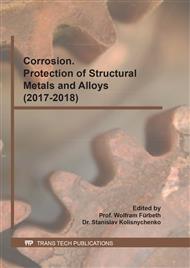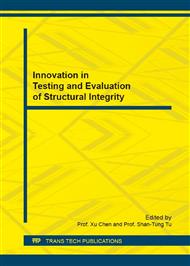p.453
p.458
p.463
p.468
p.473
p.478
p.483
p.488
p.493
Effect of Surface Strengthening on Corrosion Property of Ti-6Al-4V in 3.5% NaCl
Abstract:
By means of Ultrasonic shot peening (USSP), a strengthening surface layer was formed on Ti-6Al-4V. The polarization curves with different treatment times were investigated in 3.5% NaCl. The type of semiconductor for passivation film of 30 min treatment was measured by Mott-Schottky curve, and the thickness of the passivation film was calculated.The result of the polarization curves show that the corrosion resistance of the USSP treatment samples is increased by comparing with the untreated sample. Mott-Schottky curve of 30 min USSP treatment sample show that the passive film belongs to n-type semiconductor. The thickness of the passive film is much thicker than the untreated sample. The charge carrier density is smaller than that of untreated sample. These indicate that the surface strengthening improves the corrosion resistance of the Ti-6Al-4V in 3.5% NaCl by forming stable passive film.
Info:
Periodical:
Pages:
473-477
Citation:
Online since:
September 2016
Authors:
Keywords:
Price:
Сopyright:
© 2017 Trans Tech Publications Ltd. All Rights Reserved
Share:
Citation:



